Hortus Sanitatis
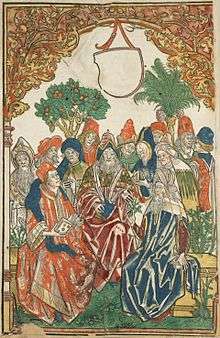 Frontispiece of 1485 edition | |
| Country | Germany |
|---|---|
| Publisher | Jacob Meydenbach, Mainz |
Publication date | 1485 |
The Hortus Sanitatis (also written Ortus) (Latin for The Garden of Health), the first natural history encyclopaedia,[1] was published by Jacob Meydenbach in Mainz, Germany in 1485.[2]
It describes species in the natural world along with their medicinal uses and modes of preparation.[3] It is in part an extended Latin translation of the German Herbarius published in 1485 but, unlike that earlier work, also deals with animals, birds, fish and stones.[4] The author does not restrict himself to dealing only with real creatures, but also includes accounts of mythical animals such as the dragon, harpy, hydra, myrmecoleon, phoenix, and zitiron.[5]
Context
The Hortus Sanitatis was the third important herbal to be printed in Mainz before 1500. The first two were by Peter Schoeffer, his Latin Herbarius in 1484, followed by an updated and enlarged German version in 1485.[6]
Publication history
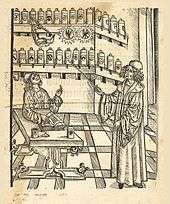
The first edition of Hortus Sanitatis was printed by Jacob Meydenbach in Mainz, Germany in 1485, with a second edition in 1491 and a third in 1497. A French edition by Antoine Vérard was printed in Paris in about 1500, under the title Ortus sanitatis translate de latin en francois.[7] The last complete copy of Hortus Sanitatis appeared in about 1539, printed by Phillipe le Noir and sold in Paris under the title of Le jardin de sante.[8]
An English version of extracts from the Hortus, the Noble lyfe & natures of man, of bestes, serpentys, fowles & fisshes, was produced in 1491 by Laurence Andrew (fl. 1510–1537). A facsimile edition of this was published in London in 1954 by B. Quaritch.[9]
Contents
The book is divided up into sections as follows:[3]
- Tractatus De Herbis ("Treatise on Herbs")
- Tractatus De Animalibus ("Treatise on Animals")
- Tractatus De Avibus ("Treatise on Birds")
- Tractatus De Piscibus ("Treatise on Fish")
- Tractatus De Lapidibus ("Treatise on Stones")
- Tractatus De Urinis ("Treatise on Urine")
- Tabula super tractatu (an alphabetic index of medicinal uses for the species in each section)
- Tabula Generis (an alphabetic list of the contained species)
Illustrations
The woodcut illustrations are stylised but often easily recognizable,[1] and many were re-used in other works.[10] In addition to the representations of simples, pictures show their use by humans, and scenes in which figures are surrounded by the subjects in their natural environment, such as standing by a river with fish and mermaids.[1] Unusually for the period, many of the woodcuts are coloured.[11]
 Woman in bed
Woman in bed A fish with the head of a pig
A fish with the head of a pig A man and a woman loading a cart
A man and a woman loading a cart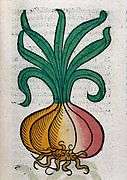 An onion
An onion Adam and Eve under the Tree of life
Adam and Eve under the Tree of life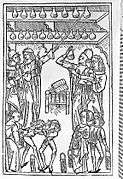 A doctor examining urine
A doctor examining urine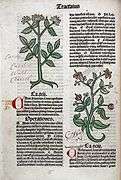
 Four insects, possibly bees
Four insects, possibly bees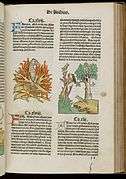
 Five breeds of dog
Five breeds of dog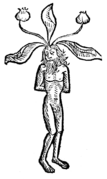 Mandrake man
Mandrake man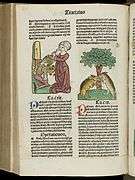 Page illustrated with a woman delousing a man
Page illustrated with a woman delousing a man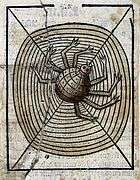 A spider on its web
A spider on its web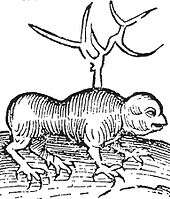 The mythical Myrmecoleon ("ant-lion"), 1491
The mythical Myrmecoleon ("ant-lion"), 1491
In culture
The University of Sydney comments that "The rich variety of the woodcuts makes this a very attractive book. The engraver was a skilled craftsman, but there is some botanical retrogression, since he did not always fully understand the plants he was copying from previous cuts."[12]
A copy once owned by the apothecary George Peacock of Aberdeen is held by the University of Aberdeen. It was described as a "rare medieval book" which gave "an insight into the bizarre medical practices used 500 years ago."[13]
References
- 1 2 3 Attenborough, David. "Ortus sanitatis". Cambridge Digital Library. Retrieved 16 October 2014.
- ↑ "Ortus sanitatis". Cambridge Digital Library. Retrieved 16 October 2014.
- 1 2 "Ortus sanitatis". Open Library. Retrieved 16 October 2014.
- ↑ Arber (2010), p. 28
- ↑ Arber (2010), pp. 34–35
- ↑ Raphael, p. 249.
- ↑ Arber (2010), p. 35
- ↑ Arber (2010), p. 36
- ↑ "An early English version of Hortus sanitatis : a recent bibliographical discovery by Noel Hudson". NLA.gov.au. Retrieved 28 February 2016.
- ↑ "Johannes de Cuba Ortus sanitatis". Royal College of Physicians of Edinburgh. Retrieved 16 October 2014.
- ↑ O'Sullivan, Keith. "Collections Highlight: Hortus Sanitatis (Garden of Health)". University of Aberdeen. Retrieved 28 February 2016.
- ↑ "Treasures of the Rare Books and Special Collections Library: Scientific works: Hortus Sanitatis. Mainz: Jacob Meydenbach, 1491". University of Sydney. 17 September 2010. Retrieved 28 February 2016.
- ↑ Shead, Sam (10 September 2012). "Rare 500-year-old illustrated medical book shows doctors analysing urine to diagnose illness and brushing lice from a boy's hair". The Daily Mail. Retrieved 28 February 2016.
Sources
- Arber, Agnes (2010) [1912]. Herbals: Their Origin and Evolution. Cambridge University Press. ISBN 978-1-108-01671-1.
- Raphael, Sandra (1986). Goode, Patrick; Lancaster, Michael, eds. Herbal. The Oxford Companion to Gardens. Oxford University Press. pp. 249–252. ISBN 0-19-866123-1.
External links
| Wikimedia Commons has media related to Hortus Sanitatis. |
| Wikimedia Commons has media related to Herbal. |
- Hortus Sanitatis (1485)
- Hortus Sanitatis (1491)
- Ortus Sanitatis published 23 June 1491. A copy with coloured illustrations in Cambridge Digital Library
- Ortus sanitatis 4th edition; 3rd Strasbourg edition. Published 1499 by J. Prüss in Strasbourg. Digitised copy in Boston Public Library